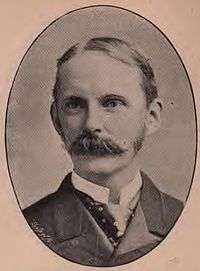East Northamptonshire (UK Parliament constituency)
| East Northamptonshire | |
|---|---|
|
Former County constituency for the House of Commons | |
| 1885–1918 | |
| Number of members | one |
East Northamptonshire was a county constituency in Northamptonshire, which returned one Member of Parliament (MP) to the House of Commons of the Parliament of the United Kingdom.
The constituency was created by the Redistribution of Seats Act 1885 for the 1885 general election, and abolished for the 1918 general election.
Boundaries
The Sessional Division of Wellingborough, and part of the Sessional Division of Kettering.
Members of Parliament
| Election | Member | Party | |
|---|---|---|---|
| 1885 | Francis Channing | Liberal | |
| 1910 | Leo Chiozza Money | Liberal | |
| 1918 | constituency abolished | ||
Election results
Elections in the 1880s

Channing
| Party | Candidate | Votes | % | ± | |
|---|---|---|---|---|---|
| Liberal | Francis Allston Channing | 5,414 | n/a | ||
| Conservative | Richmond Ramsden | 3,359 | n/a | ||
| Majority | 2,055 | n/a | |||
| Turnout | n/a | ||||
| Liberal win (new seat) | |||||
| Party | Candidate | Votes | % | ± | |
|---|---|---|---|---|---|
| Liberal | Francis Allston Channing | 4,428 | |||
| Conservative | Leopold George Frederick Agar-Ellis | 3,012 | |||
| Majority | 1,416 | ||||
| Turnout | |||||
| Liberal hold | Swing | ||||
Elections in the 1890s
| Party | Candidate | Votes | % | ± | |
|---|---|---|---|---|---|
| Liberal | Francis Allston Channing | 5,832 | |||
| Conservative | William Potter | 4,348 | |||
| Majority | 1484 | ||||
| Turnout | |||||
| Liberal hold | Swing | ||||
| Party | Candidate | Votes | % | ± | |
|---|---|---|---|---|---|
| Liberal | Francis Allston Channing | 6,177 | |||
| Conservative | Herbert William Lush-Wilson | 4,961 | |||
| Majority | 1,216 | ||||
| Turnout | |||||
| Liberal hold | Swing | ||||
Elections in the 1900s
| Party | Candidate | Votes | % | ± | |
|---|---|---|---|---|---|
| Liberal | Francis Allston Channing | 7,003 | |||
| Conservative | John Charles Denham Parker | 5,563 | |||
| Majority | 1,440 | ||||
| Turnout | |||||
| Liberal hold | Swing | ||||
| Party | Candidate | Votes | % | ± | |
|---|---|---|---|---|---|
| Liberal | Francis Allston Channing | 9,017 | |||
| Conservative | Sir Arthur Richard de Capell-Brooke | 5,414 | |||
| Majority | 3,603 | ||||
| Turnout | |||||
| Liberal hold | Swing | ||||
Elections in the 1910s
| Party | Candidate | Votes | % | ± | |
|---|---|---|---|---|---|
| Liberal | Sir Francis Allston Channing | 8,679 | |||
| Conservative | Sir Arthur Richard de Capell-Brooke | 6,802 | |||
| Majority | |||||
| Turnout | |||||
| Liberal hold | Swing | ||||
Richards

Money
| Party | Candidate | Votes | % | ± | |
|---|---|---|---|---|---|
| Liberal | Leo George Chiozza Money | 7,430 | |||
| Conservative | Sir Arthur Richard de Capell-Brooke | 6,676 | |||
| Labour | Thomas Frederick Richards | 1,431 | n/a | ||
| Majority | |||||
| Turnout | |||||
| Liberal hold | Swing | ||||
General Election 1914/15:
Another General Election was required to take place before the end of 1915. The political parties had been making preparations for an election to take place and by the July 1914, the following candidates had been selected;
- Liberal: Leo George Chiozza Money
- Unionist: Capt. C.J.O. Mansell
- Labour: R.J. Davies
References
This article is issued from
Wikipedia.
The text is licensed under Creative Commons - Attribution - Sharealike.
Additional terms may apply for the media files.